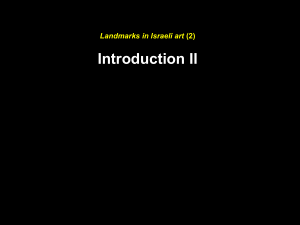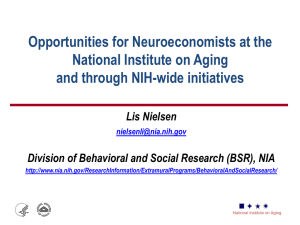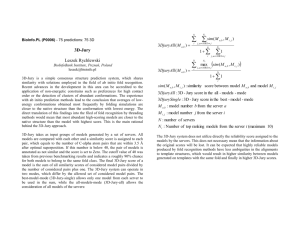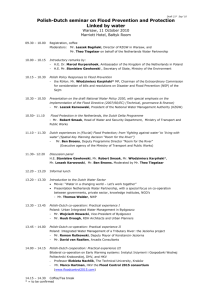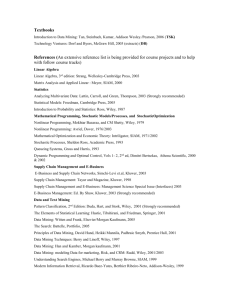Trust, Privacy, and Security - Computer Science
advertisement
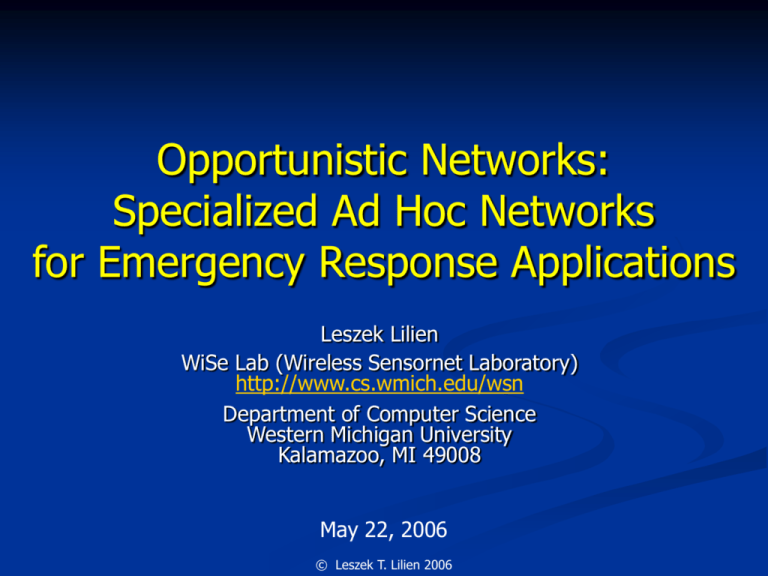
Opportunistic Networks: Specialized Ad Hoc Networks for Emergency Response Applications Leszek Lilien WiSe Lab (Wireless Sensornet Laboratory) http://www.cs.wmich.edu/wsn Department of Computer Science Western Michigan University Kalamazoo, MI 49008 May 22, 2006 © Leszek T. Lilien 2006 Outline Part 1. Motivation for Specialized Ad Hoc Networks Part 2. Analogy to a Human Emergency Response Team Part 3. Opportunistic Networks: A New Type of Specialized Ad Hoc Networks Part 4. Related Research and Research Challenges Part 5. Conclusions Part 6. Current and Future Work 5/22/06 © Leszek T. Lilien 2006 2 Part 1. Motivation for Specialized Ad Hoc Networks Homeland Security One of the crucial challenges facing the USA today Among its 6 mission areas is Emergency Preparedness and Response (EPR) EPR deals with: Natural disasters Man-made disasters (incl. accidents, terrorist attacks) [Natl. Strategy for Homeland Security, July 2002] 5/22/06 Mobile ad hoc networks (MANETs) proposed for EPR © Leszek T. Lilien 2006 [Haas, 1999] 3 Motivation for Specialized Ad Hoc Networks (2) 5/22/06 MANETS are not quite a natural match for EPR E.g., human rescue teams can find and mobilize as their helpers local firemen, police, National Guard or even regular citizens No analogous capability of MANETs to find and “mobilize” devices/networks Let’s find or define a specialization (a subclass) of ad hoc networks more suitable for EPR applications A new paradigm and a new technology to improve effectiveness & efficiency of EPR © Leszek T. Lilien 2006 4 This page left blank intentionally. 5/22/06 © Leszek T. Lilien 2006 5 Part 2. Analogy to a Human Emergency Response Team Important characteristics of a human rescue team Starts as a seed team (a small group of people) The seed team grows opportunistically during its operations a) Some people can always be ordered to join Police, firemen, National Guard or Army Reserve personnel b) Anybody can be ordered to join only in life-or-death situations Legally required to help saving lives or critical resources c) Anybody can be asked to join in other situations 5/22/06 © Leszek T. Lilien 2006 6 Analogy to a Human Emergency Response Team (2) Who is ordered or invited to join? In some situations any extra pair of hands can help In others only highly qualified people (e.g., doctors and nurses) are ordered/asked to join Human helper types Highly prepared E.g., National Guard, Army Reserve or state militias 5/22/06 (even unforeseen) Somewhat prepared E.g., people that volunteer for first aid courses Signed up for service Undergo training in preparation for duty Become pretty valuable helpers in emergencies Not prepared at all © Leszek T. Lilien 2006 7 Analogy to a Human Emergency Response Team (3) Benefits of the opportunistic growth of the rescue team Opportunistic leveraging of all kinds of skills and resources that new helpers can bring 5/22/06 Obtaining a lot of help effectively and efficiently – even for free © Leszek T. Lilien 2006 8 Analogy to a Human Emergency Response Team (4) Analogous critical requirements for ad hoc network specialized for EPR in the priority order: 1) Minimal starting configuration – a pre-configured seed for EPR operations Analogy to the seed rescue team 2) High interoperability in terms of communication of diverse devices or networks (Wired/WiFi, Bluetooth, satellite, ham radios, WiMAX, ...) Analogy to a rescue team’s ability to contact different people, individually or via organizations 3) Highly heterogeneous software (& hardware) Analogy to heterogeneity of rescue teams in terms of members’ skills, communication and other equipment, and other resources 4) Harvesting of diverse resources as needed Analogy to finding people with different skills, equipment, and other resources 5) Persistent connectivity once it is established Analogy to being able to contact (maybe via a chain of others) members of the expanded team, including all helpers 5/22/06 © Leszek T. Lilien 2006 9 Analogy to a Human Emergency Response Team (5) If there is no specialized ad hoc network (AHN) matching the requirements, then: Define a new specialized AHN paradigm Invent a new specialized AHN technology No known specialized AHN matches the requirements Considered AHNs: Mobile ad hoc networks (MANETs) Mesh networks P2P systems Sensor networks Spontaneous networks (in the narrow sense, cf. [Feeney et al. 2001]) => Need: - a new specialized AHN paradigm - a new specialized AHN technology 5/22/06 © Leszek T. Lilien 2006 10 This page left blank intentionally. 5/22/06 © Leszek T. Lilien 2006 11 Part 3. Opportunistic Networks: A New Type of Specialized Ad Hoc Networks Paradigm of Opportunistic Networks (Oppnets) Based on the analogy to operations of human rescue teams Goals of oppnets: Opportunistic growth Opportunistic leveraging of resources aiming at (among others): Bridging diverse communication media Offloading computations to additional platforms Integrating independent sensing systems (enhancing their sensing capabilities) 5/22/06 © Leszek T. Lilien 2006 12 Startup: Seed Oppnet Oppnet deployed as a seed oppnet Link to the World Seed Nodes Controller (distributed) 5/22/06 Seed oppnet localizes its nodes & self-configures © Leszek T. Lilien 2006 13 Growth: Expanded Oppnet Seed oppnet grows into an expanded oppnet by: Finding candidate helpers Selecting candidates - they are ordered/asked to join Add communication, computing, sensing, storage, other resources Satellite Link to the World Appliance (refrigerator) Cellphone Tower Seed Nodes Controller (distributed) WiMAX Overturned Vehicle (with OnStar) 5/22/06 © Leszek T. Lilien 2006 Computer Network 14 Summary of Oppnet Activities Discovering & identifying candidate helpers Contacting selected candidates Inviting or ordering candidates to join Admitting & integrating helpers that join oppnet Offloading tasks to helpers 5/22/06 Determining useful colaborative functionalities Managing offloaded tasks Cleaning up & releasing each helper when no longer needed © Leszek T. Lilien 2006 15 Oppnet Reserve A challenge in oppnet growth Must discover candidate helpers, then contact selected ones Difficult without facilities provided by candidates or infrastructure A solution: oppnet reserve — facilitating discovery/contacting Analogy to Army / Navy / Air Force Reserve, etc. Volunteer helpers sign up for oppnet reserve Maybe for some incentives Volunteers „trained” for active duty Install facilities that make them easier to detect and contact by oppnets E.g., install (future) standard oppnet protocols 5/22/06 (moral, financial, etc.) Matched to their capabilities: heavy-, medium- and lightweight Available for active oppnet duty whenever must/can help © Leszek T. Lilien 2006 16 Oppnet Reserve (2) Oppnet reserve is analogous to having highly prepared human helpers (Recall the classification of human helpers into: highly prepared, somewhat prepared, unprepared) Oppnet reserve is not required but very helpful 5/22/06 Having highly prepared human helpers is not required either © Leszek T. Lilien 2006 17 Basic Oppnet Categories 2 major oppnet categories: Benevolent oppnets Malevolent oppnets Corresponding oppnets scenarios: Benevolent oppnet scenario: „Citizens Called to Arms” 5/22/06 Malevolent oppnet scenario: „Bad Guys Gang Up” © Leszek T. Lilien 2006 18 Benevolent Oppnet Scenario: „Citizens Called to Arms” (1) Seed oppnet deployed after an earthquake (un- 19 predictable emergency) Seed is ad hoc wireless network with very powerful nodes Seed tries to detect candidate helpers For help in damage assessment and disaster recovery Uses any available detection method — including: 5/22/06 More energy, computing and communication resources Cellphone- or radio-based detection Searching for nodes using the IP address range for the affected geographic area AI-based visual detection (next) © Leszek T. Lilien 2006 19 Benevolent Oppnet Scenario: „Citizens Called to Arms” (2) 5/22/06 Example: Helper 1 (supervisor of security cameras) monitoring a surveillance net views an overturned car Helper 2 (pattern recognition specialist) detects an overturned car Helper 3 (image analysis specialist) asked to recognize its license plate Helper 4 (DB manager) finds that the cars has OnStar link Helper 5 (OnStar agent) contacts BANs (Body Area Networks) on or within bodies of car occupants via OnStar infrastructure Helper 6 (vital sign evaluator) evaluates obtained info Helper 7 (rescue dispatcher) decides if/when rescuers should be dispatched © Leszek T. Lilien 2006 20 20 Benevolent Oppnet Scenario: „Citizens Called to Arms” (3) 21 Oppnet selects optimal subset of detected nodes Inviting devices, clusters & entire networks Helpers for communicating, sensing, computing Using „hidden” capabilities, e.g. for sensing: Desktop can „sense” presence of a potential victim at its keyboard Cellphones can „sense” location 5/22/06 Even ones w/o GPS can be triangulated © Leszek T. Lilien 2006 21 Benevolent Oppnet Scenario: „Citizens Called to Arms” (4) 5/22/06 Using „hidden” emergency functionalities Oppnet contacts 2 independent sensornets (SNs): water infrastructure control SN / public space surveillance SN SNs ordered to abandon normal functions & help in rescue & recovery operations Water infrastructure SN (with multisensor capabilities, under road surfaces) — ordered to sense vehicular movement and traffic jams Public space surveillance SN — ordered to search for images of human victims © Leszek T. Lilien 2006 22 22 Malevolent Oppnet Scenario: „Bad Guys Gang Up” (1) Scenario 1 — Terrorists create apparently harmless weather monitoring sensornet (SN): SN becomes a seed of a malevolent opportunistic SN SN exploits other nodes from many other networks 23 (w/o revealing its true goals) “Critical mass” of the opportunistic SN is reached (in terms of geographical spread and sensing capabilities) SN waits for wind patterns that can speed up spread of poisonous chemicals 5/22/06 Collected data used to decide when to start chemical attack © Leszek T. Lilien 2006 23 Malevolent Oppnet Scenario: „Bad Guys Gang Up” (2) Scenario 2 — network at home starts spying on you: Becomes a seed oppnet Exploits other devices/nets to collect all info on you: 5/22/06 From your fridge (& RFID-equipped food packaging): what/when you eat From your computer: keylogs your passwords, sensitive data From your cellphone: who you call & when From your networked camera: what photos you take From your home security surveillance system: your private images Cyberfly with camera eyes and microphone ears ... Huge privacy problem! / Huge security problem! Controls to counteract malevolent oppnets badly needed © Leszek T. Lilien 2006 24 This page left blank intentionally. 5/22/06 © Leszek T. Lilien 2006 25 Part 4. Related Research and Research Challenges Examples of Related Research Interoperability Among wireless networks - active research area Among WANs, MANs, LANs, PANs (Personal Area Networks), etc. Among wired & wireless nets - much less research Ambient Networks (big European Union project, next-generation Internet—for 2015/2020, smaller networks able to compose themselves into bigger ones) Localization and self-organization Network growth 5/22/06 P2P systems – search for peers in unstructured systems Trojan Horses - agents spreading in search for helpers Integrating and managing heterogeneous systems, incl. data integration & aggregation MANETs / Sensornets Grid systems / MANETs / Sensornets Other … © Leszek T. Lilien 2006 26 Research Challenges in Basic Operations Challenges in seed oppnet deployment E.g., localization, self-configuration, adaptability Challenges in detecting helper systems E.g., define primitives to detect candidates, identify and categorize them, evaluate and classify them (e.g., based on dependability and usefulness) Challenges in inviting & admitting candidate helpers E.g., select candidates to invite, develop protocols for candidates to accept or reject invitation, devise primitives /methods to manage expanded oppnets Etc., etc. for remaining oppnet primitives More: Leszek Lilien, Z. Huma Kamal, and Ajay Gupta, "Opportunistic Networks: Research Challenges in Specializing the P2P Paradigm,” Proc. 3rd International Workshop on P2P Data Management, Security and Trust (PDMST’06), Kraków, Poland, September 2006 (to appear) 5/22/06 © Leszek T. Lilien 2006 27 Research Challenges in Privacy & Security (1) 1) Privacy challenges in oppnets Privacy is critical Oppnets are pervasive systems Must face all critical privacy challenges inherent to pervasive computing Privacy is a „make it or break it” issue for pervasive computing => Privacy is a „make it or break it” issue for oppnets Basic privacy protection goals in oppnets Protect helper resources from the host oppnet Protect oppnet from its helpers Protect environment from privacy violations by oppnet 5/22/06 Also from malevolent oppnets © Leszek T. Lilien 2006 28 Research Challenges in Privacy & Security (2) 2) Security challenges in oppnets Many have privacy aspects/components More: Leszek Lilien, Z. Huma Kamal, Vijay Bhuse and Ajay Gupta, "Opportunistic Networks: The Concept and Research Challenges in Privacy and Security,” Proc. International Workshop on Research Challenges in Security and Privacy for Mobile and Wireless Networks (WSPWN 2006), Miami, Florida, March 2006. 5/22/06 © Leszek T. Lilien 2006 29 This page left blank intentionally. 5/22/06 © Leszek T. Lilien 2006 30 Part 5. Conclusions High-payoff potential for the oppnet initiative 1) Social and economic benefits Including reduction of human suffering & loss of life 2) Technological benefits 3) Research benefits 4) Educational benefits -- Details below -- 5/22/06 © Leszek T. Lilien 2006 31 1) Social & Economic Impacts Impacts on Emergency Preparedness and Response operations in Homeland Security (HS) — current app focus Tremendous leveraging potential in emergencies A wealth of freely available resources Reduction of human suffering & loss of life Increasing safety & efficiency of the first responders Impacts on other applications both in HS and outside HS Economic impacts Technology transfer & commercialization Benefits for the computer industry Benefits for other industries 5/22/06 Production of software / networking equipment Enhancing many products with standard oppnet interfaces E.g., the auto industry: cars and trucks as oppnet platforms © Leszek T. Lilien 2006 32 2) Impacts on Technology 5/22/06 Advancing the network and pervasive computing know-how Development of the innovative oppnet technology Enhancing network/pervasive applications by use of oppnet technologies Enabling new network/pervasive application niches we can not even foresee Advancing other areas of technology (not only computing) A side effect of oppnet developments Technology impacts speeded up & enhanced by the planned technology transfer plus commercialization activities © Leszek T. Lilien 2006 33 3) Impacts on Research Encouraging oppnet research 1) Building our oppnet research team at WMU 4 professors, 2 Ph.D. students (incl. a Ph.D. dissertation), other students 2 high-tech companies specializing in EPR products 2) 3) Summer 2006: 1 more Ph.D. student, ≥ 1 M.S. students Fall 2006: many student projects Initiating research collaboration with researchers outside of the WMU Encouraging independent oppnet research Applying for state, NSF, and other funding for Ph.D. students and other students, post docs, and visiting faculty Dissemination of research results and products: 5/22/06 From Ann Arbor - Michigan’s equivalent of the Sillicon Valley Presentations: publications, seminars, poster sessions A dedicated web site Public availability of the oppnet prototype, tools & data © Leszek T. Lilien 2006 34 4) Impacts on Education Impact on students For project participants: hands-on training on the B.S./M.S./Ph.D levels For others: course enhancements / course projects / seminars 5/22/06 Oppnet prototype used for lab experiments Outreach activities Including K-12 demos for underrepresented minorities All activities will broaden the America’s talent pool in critical technologies and applications Training more minority & female students at all levels © Leszek T. Lilien 2006 35 This page left blank intentionally. 5/22/06 © Leszek T. Lilien 2006 36 Part 6. Current and Future Work Building an oppnet prototype Goal: Proof of concept To demonstrate technical prowess & economic benefits Designing oppnet architecture With its associated components: Oppnet prototype implementation For stimulation and feedback 5/22/06 Methods, protocols, and algorithms Necessary for fine-tuning oppnet design Technology transfer & commercialization Mentioned above © Leszek T. Lilien 2006 37 More Details of Oppnet Prototyping Building state-of-the-art lab facilities Constructing an oppnet prototype in the lab 5/22/06 Developing performance analysis tools to support testing & fine-tuning activities Extending the prototype to include living-laboratory resources available in our sensor- & computer-rich building Testing the prototype within the living laboratory For fine-tuning design & implementation Obtaining external assessment of the prototype From computer & homeland security labs in MI, IN, IL © Leszek T. Lilien 2006 38 Search for Other Oppnet Applications 5/22/06 Search for oppnet utilization in all kinds of application areas Search for applications that ... ... can start with a seed ... need high interoperability ... need highly heterogeneous software ... can benefit from leveraging diverse resources of helpers ... can maintain persistent connectivity once it is established ... Welcome collaboration or independent contributions Seeking funding that will allow to fund: Ph.D. students (dissertations on oppnets) Post docs (e.g., 3-12 months) Visiting faculty (e.g., 1-6 months) © Leszek T. Lilien 2006 39 Publications on Oppnets (intensive work on oppnets started in our WiSe Lab in December 2005) 1. 2. Leszek Lilien and Ajay Gupta, ” Opportunistic Networks for Emergency Preparedness and Response” (submitted for publication). Leszek Lilien, Z. Huma Kamal, and Ajay Gupta, "Opportunistic Networks: Research Challenges in Specializing the P2P Paradigm,” Proc. 3rd International Workshop on P2P Data Management, Security and Trust (PDMST’06), Kraków, Poland, September 2006 (to appear) 3. 4. Leszek Lilien, “Developing Specialized Ad Hoc Networks: The Case of Opportunistic Networks,” Proc. Workshop on Distributed Systems and Networks at the WWIC 2006 Conference, Bern, Switzerland, May 2006 (invited paper, proceedings to appear). Leszek Lilien, Z. Huma Kamal, Vijay Bhuse and Ajay Gupta, "Opportunistic Networks: The Concept and Research Challenges in Privacy and Security,” Proc. International Workshop on Research Challenges in Security and Privacy for Mobile and Wireless Networks (WSPWN 2006), Miami, Florida, March 2006. 5. 5/22/06 B. Bhargava, L. Lilien, A. Rosenthal, and M. Winslett, “Pervasive Trust,” IEEE Intelligent Systems, vol. 19(5), Sep./Oct.2004, pp. 74-77 (first brief mention of the oppnet idea, in the form of malevolent opportunistic sensor networks). © Leszek T. Lilien 2006 40 Selected WiSe Lab Publications on Privacy, Trust, Security, Pervasive Computing & Sensornets 1. 2. 3. 4. 5. 6. 7. 8. 9. 10. 11. 12. 13. 14. 15. 5/22/06 V. Bhuse, A. Gupta, and L. Lilien, "Research challenges in lightweight intrusion detection for sensornets" (submitted for publication). L. Lilien and B. Bhargava, ”A Scheme for Privacy-preserving Data Dissemination,” IEEE Transactions on Systems, Man and Cybernetics (to appear). T. Canli, M. Terwilliger, A. Gupta and A. Khokhar, "Power Efficient Algorithms for Computing Fast Fourier Transform over Wireless Sensor Networks," Proc. Fourth ACS/IEEE Conference on Computer Systems and Applications, Dubai, UAE, March 2006. V. Bhuse, A. Gupta and L. Lilien, "DPDSN: Detection of packet-dropping attacks for wireless sensor networks," Proc. 4th International Trusted Internet Workshop (TIW), International Conference on High Performance Computing, Goa, India, December 2005. A. Gupta and V. Bhuse, “Anomaly Intrusion Detection in Wireless Sensor Networks," Journal of High Speed Networks, vol. 15, issue 1, January-March 2006. M. Terwilliger, A. Gupta, A. Khokhar and G. Greenwood, "Localization using Evolution Strategies in Sensornets," Proc. IEEE Congress on Evolutionary Computation, Edinburgh, UK, September 2005. V. Bhuse, A. Gupta, M. Terwilliger, Z. Yang and Z. Kamal, "Using Routing Data for Information Authentication in Sensor Networks," Proc. 3rd International Trusted Internet Workshop (TIW), International Conference on High Performance Computing, Bangalore, India, December 2004. T. Canli, M. Terwilliger, A. Gupta and A. Khokhar, "Power-Time Efficient Algorithm for Computing FFT in Sensor Networks," (Extended Abstract). Proc. Second ACM Conference on Embedded Networked Sensor Systems (SenSys), Baltimore, Maryland, November 2004. B. Bhargava, L. Lilien, A. Rosenthal, and M. Winslett, “Pervasive Trust,” IEEE Intelligent Systems, vol. 19(5), Sep./Oct.2004, pp. 7477. B. Bhargava and L. Lilien, “Private and Trusted Collaborations,” Proc. Secure Knowledge Management (SKM 2004): A Workshop, Amherst, NY, Sep. 2004. M. Jenamani, L. Lilien, and B. Bhargava, “Anonymizing Web Services Through a Club Mechanism with Economic Incentives,” Proc. International Conference on Web Services (ICWS 2004), San Diego, California, July 2004, pp. 792-795. Z. Kamal, M. Salahuddin, A. Gupta, M. Terwilliger, V. Bhuse and B. Beckmann, "Analytical Analysis of Data and Decision Fusion in Sensor Networks," Proc. 2004 International Conference on Embedded Systems and Applications. Las Vegas, June 2004. M. Terwilliger, A. Gupta, V. Bhuse, Z. Kamal, and M. Salahuddin, "A Localization System Using Wireless Sensor Networks: A Comparison of Two Techniques," Proc. 2004 Workshop on Positioning, Navigation and Communication, Hanover, Germany, March 2004 , pp. 95-100. V. Bhuse, A. Gupta and R. Pidva, "A Distributed Approach to Security in Sensornets," Proc. 58th IEEE Semiannual Vehicular Technology Conference, Orlando, Florida, USA, October 2003. L. Lilien, “Developing Pervasive Trust Paradigm for Authentication and Authorization,” Proc. Third Cracow Grid Workshop (CGW’03), Kraków (Cracow), Poland, October 2003, pp. 42-49 (invited paper). © Leszek T. Lilien 2006 41 WiSe Lab Experience in Sensornets – Selected Projects Since January 2003 NOTE: Results directly useful for oppnets are marked with an asterisk (*) 5/22/06 Designing of WiSe Security Protocols: DSPS Location Tracker Using Motes (*) RHS: Remote Home Surveillance (*) Directed Diffusion: Attacks & Countermeasures Improving the Accuracy of Mote Measurements by Using Neural Networks SOMS: Smart Occupancy Monitoring System Using Motes (*) Comparative Study of Network Simulators Collaborative Image Processing (*) DENSe: a Development Environment for Networked Sensors Incorporating Mobile-ware in Distributed Computations / Grids (*) Extending the ns-2 Simulator to Satellite and WCN Simulations Smart Antennas for WCNs Energy Efficient MAC Protocols for IEEE 802.11x A Wireless Security Testing System (*) Mobile and Self-Calibrating Irrigation System Collective Communications for Sensornets (*) © Leszek T. Lilien 2006 42 Thank you very much for your time and attention! 5/22/06 © Leszek T. Lilien 2006
